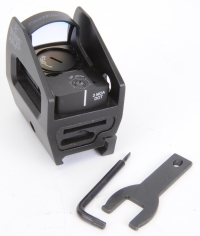 If you haven’t seen this one, Burris has combined their FastFire III product with a new mount specifically designed for at AR Flat Top type firearms. The winged mount guards the sight and raises it to proper eye level for use as a standalone or co-witness arrangement of quick deploy and other metallic sights. The mount also stows a battery and two combination tools that are used to change batteries and to adjust and install the sight. The mount fits both Weaver and Picatinny bases.
If you haven’t seen this one, Burris has combined their FastFire III product with a new mount specifically designed for at AR Flat Top type firearms. The winged mount guards the sight and raises it to proper eye level for use as a standalone or co-witness arrangement of quick deploy and other metallic sights. The mount also stows a battery and two combination tools that are used to change batteries and to adjust and install the sight. The mount fits both Weaver and Picatinny bases.
Should applications change and the FastFire III is needed for other firearms, $30 – $50 will purchase another mount for many popular rifles and handguns. Bases are easy to change, requiring only removal and replacement of a couple of Torx Fasteners…. tools included with this sight package.
The heart of the AR-F3 –is the FastFire III
It took me a while to learn how to use red dot sights effectively and to sort out the good ones from the bad. Using them effectively was a matter of me breaking old habits and using them as intended. Where someone younger, more open minded and with more hair could probably learn in a few minutes, unfortunately, I just kept looking through the dot and waiting for a front site to come into view. Eventually, I started shooting with both eyes open, ignoring the sight’s frame and shooting to the red dot and I found the speed and ease of targeting I had been missing.
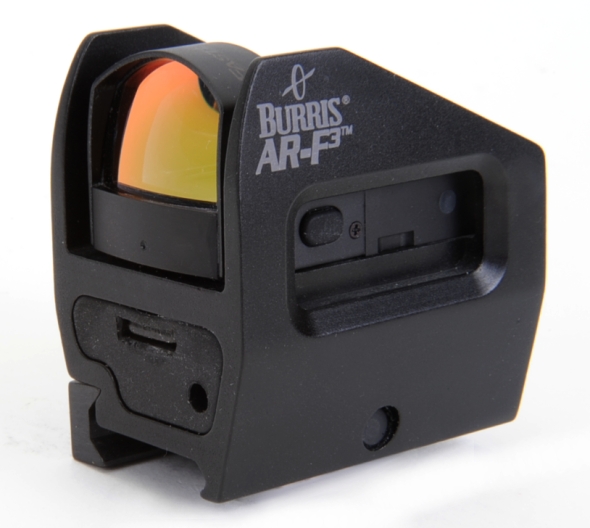
The second issue of sorting out the good products from the not so good was not as simple, but eventually the desirable characteristics came to the surface. The first issue was parallax. Cheaply made red dot sights, particularly those enclosed in a tube, can have a good deal of parallax. They requires the shooter’s eye to be perfectly in line with a sight’s optical center, which defeats the primary benefit of a reflex sight, speed. Good red dot sights should allow the shooter to keep both eyes opened for an unlimited field of view, and whether looking from the side of the image frame or looking down the center the shooter should still score a hit. The only requirement should be placing the dot on the target before pulling the trigger.
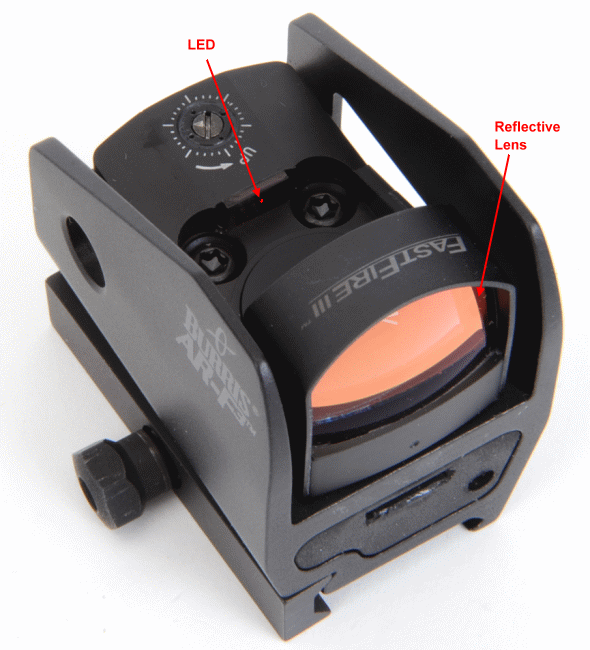
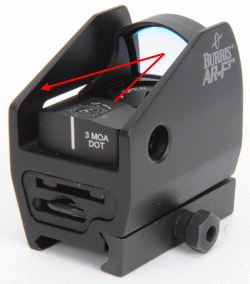 Like products costing 2 to 3 times the price of the Burris unit, The FastFire III has a two element, multi coated front lens that reflects and then refracts light straight back to the shooter. Both lenses are multicoated outside and the narrow band reflective surface is sandwiched, protected, between the two elements. The LED is positioned higher than in closed tube sights, and the viewing lens is angled rearward slightly to minimize the angle of incidence of the projected and reflected red dot.
Like products costing 2 to 3 times the price of the Burris unit, The FastFire III has a two element, multi coated front lens that reflects and then refracts light straight back to the shooter. Both lenses are multicoated outside and the narrow band reflective surface is sandwiched, protected, between the two elements. The LED is positioned higher than in closed tube sights, and the viewing lens is angled rearward slightly to minimize the angle of incidence of the projected and reflected red dot.
If there is anything noticeable about the optics when viewed on the bench, it is a slight blue coloration at the extreme top edge of the viewing lens> that usually comes with cast rather than ground glass optics. However, the first product type noted retails in the $700 – $800 range without mounts, while the Burris FastFire III is typically priced without mounts in the $225 – $250 range… which means I found the blue cast to be an exceptionally attractive feature.
FastFire II Vs FastFire III
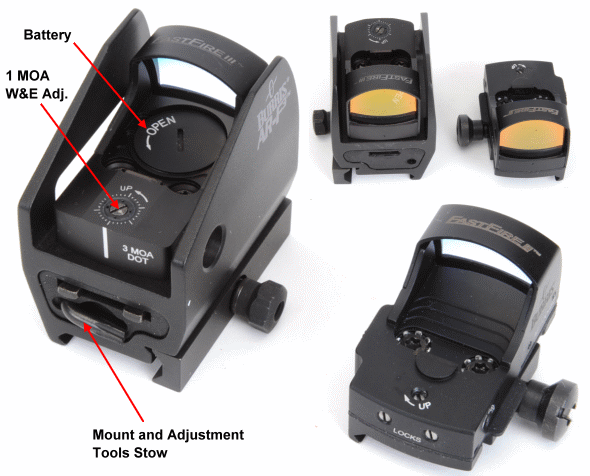
For folks familiar with the FastFire II, the FastFire III offers some significant improvements. The FastFire III dot is now available optionally as 3 MOA or 8 MOA products rather than only with the FastFire II’s 4 MOA dot. This makes the III a little quicker on target and less obscuring of a target at longer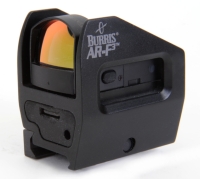 ranges with the small dot and fast in short range target acquisition when ordered with the large dot. Access to the 10,000 hour battery has been moved to the top of the unit for easy servicing, rather than on the bottom side as was the case with the II.
ranges with the small dot and fast in short range target acquisition when ordered with the large dot. Access to the 10,000 hour battery has been moved to the top of the unit for easy servicing, rather than on the bottom side as was the case with the II.
Windage and elevation adjustment has been vastly improved, beefed up and no longer require a scaled wheel to be attached for measured adjustment. Increment of adjustment is 1 MOA and lock screws are no longer required.
The power button, the oval button seen through the side of the guard is now multi function. The FastFire II had auto brightness control, where the FastFire III has auto and step setting; auto, high, medium and low brightness. Repeat depression of the button cycles the brightness settings. No more taping light sensors to brighten the dot and it appears the auto function has been recalibrated.
More general specifications:
|
Burris AR-F3 |
|
| Included: | |
|
FastFire III |
|
|
Torx Wrench |
|
|
Protective Cover |
|
|
Battery 3V CR1632 |
|
|
Guarded Weaver/Picatinny Mount |
|
|
Instructions |
|
| Specifications: | |
| Magnification | 1.07x |
| Sight Window | 21mmx15mm |
| Elevation Adjustment | 190″@100 Yards |
| Windage Adjustment | 190″@100 Yards |
| Adjustment Increment | 1 MOA |
| Subtension of Aiming Dot | 3 MOA |
| Recoil Resistance | 1000+ Gs |
| Operating Temperature Range | -10ºF to +130ºF |
| Storage Temperature Range | -40ºF to +160ºF |
| Dimensions (LxWxH) | 1.9″x1.0″x1.0″ |
| Weight | 0.9 Oz. |
| Parallax Free | 150 yards |
A couple of notes regarding construction. The unit is sealed which keeps dust, water and snow out. The FastFire III is listed as submersible with the note that if submerged in salt water, the unit should be flushed off with distilled water to protect the unit’s finish and optical coatings. As far as toughness goes, the FastFire III mechanical parts are made of a combination of stainless steel, bronze and anodized aluminum. Because of its durable construction and light weight, it can be mounted directly to the slide of a big bore autoloader.
Helpful to even Mr. Magoo… Me
There are many circumstances and types of firearms that really don’t lend themselves to a telescopic sight. As an example, pig hunting with a 45-70 Guide Gun, or an big bore AR and maybe just a big bore anything. Open and peep sights can take care of a part of it, but they are not the fastest solution and they can sometimes pose a problem for eye glass wearers. I use a FastFire sight routinely in the situations noted and that has given me back the ability to shoot accurately without a scope.
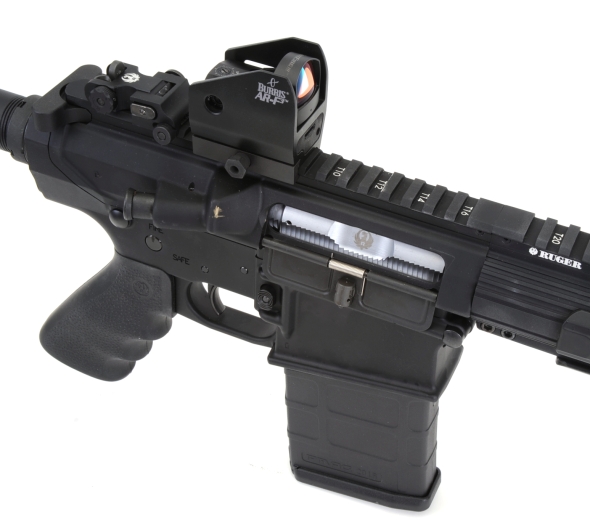
This new package, the AR-F3 is just the right height for a flattop. It allows proper head/eye position without having to play with adding risers and they really do work in concert with Quick Deploy sights. I just use one on an assessment of a Ruger AR-762, rear sight folded down in the picture above. Very nice product; good performance, compact and light and a good value.

Email Notification